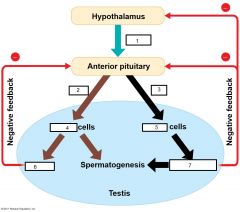![]()
![]()
![]()
Use LEFT and RIGHT arrow keys to navigate between flashcards;
Use UP and DOWN arrow keys to flip the card;
H to show hint;
A reads text to speech;
33 Cards in this Set
- Front
- Back
|
Fission |
- Separationof a parent organism into two individuals of approximately equal size |
|
|
Budding: |
New individuals arise from outgrowthsof existing ones |
|
|
Parthogenesis |
Eggdevelops without being fertilized; progeny can be either haploid or diploid |
|
|
Asexual Reproduction |
- Advantageous in stable, favorable environmentsbecause it perpetuates successful genotypes - Two-Step Process of fragmentation and regeneration |
|
|
Fragmentation |
breakingof the body into pieces, some or all of which develop into adults |
|
|
regeneration |
regrowthof lost body parts |
|
|
“twofoldcost” |
sexualfemales have half as many daughters as asexual females; this is the __________ of sexual reproduction |
|
|
- Increase in offspring variation (leads to reproductive success) - Increase in rate of adaptation - Elimination of harmful genes from population |
Sexual reproduction results in genetic recombination, which provides 3 potential advantages |
|
|
estrouscycle |
- theendometrium (layer of the uterus) is reabsorbed at the end of the cycle. –Somespecies still show a small bleed (often pre-cycle) which means they are fertile –Thefemales are not sexually active during certain seasons. Reproductiveorgans literally change shape or alignment. |
|
|
hermaphroditism |
Eachindividual has male and female reproductive systems so two of them can mate or even one of them can self-fertilize |
|
|
fertilization |
•theunion of egg and sperm, play an important part in sexual reproduction |
|
|
Copulation |
- Doesn't exactly mean internal fertilization, but it refers to when sperm enters the female's body |
|
|
cloaca |
commonopening between the external environment and the digestive, excretory, andreproductive systemscommonin nonmammalian vertebrates |
|
|
Monogamy |
- relativelyrare among animals - somespecies have evolved mechanisms to decrease the chance of their mate matingwith another individualand cansometimes influence the relative reproductive success of their mates |
|
|
corpusluteum |
secretesestradioland progesterone that helps to maintain pregnancy. progesterone helpsimplantation to uterine wall. Tells egg to grow and stay there |
|
|
Placenta |
- Eventually takes over progesterone release if implantation occurs |
|
|
Progesterone |
- 2 days after corpus luteum forms, the lack of this hormone causes endometrium to start sloughing off if egg is not fertilized |
|
|
Endometriosis |
-A disorder in which tissue that normally lines the uterus grows outside the uterus. - Lininggetting aggravated and inflamed. Don’t want it to be vascularized. |
|
|
hysterectomy |
a surgical operation to remove all or part of the uterus. |
|
|
Leydigcells |
Stimulated by LH, scattered in connective tissue between the tubules,produces testosterone and other androgens, which promote spermatogenesis in thetubules |
|
|
Epididymis |
stores the mature sperm cells. Where theactual muscular contraction occurs to ejaculate |
|
|
Seminal Vesicles Prostate Gland Bulbourethral Gland |
Semen is composed of sperm plus secretionsfrom three sets of accessory glands What are they? |
|
|
Seminal Vesicles
|
- Contribute about 60% to total semen volume
- Thick, yellowish and alkaline fluid. And mucus, sugar fructose whichprovides sperm's energy, a coagulating enzyme, ascorbic acid and localregulators called prostaglandins. |
|
|
prostategland |
Produces fluid that is thin,milky with anticoagulant enzymes and citrate (sperm nutrient). |
|
|
bulbourethral glands |
- Produces fluid that is a clearmucus that neutralizes any acidic urine remaining in the urethra |
|
|
–Allfour products of meiosis develop into sperm while only one of the four becomesan egg –Spermatogenesisoccurs throughout adolescence and adulthood –Spermare produced continuously without the prolonged interruptions in oogenesis |
3 ways Spermatogenesis differs from Oogenesis |
|
|
1. Primary 2. Secondary 3. Fertilization |
In Oogenesis, the __1__ oocyte that is present at birth is arrest in prophase of Meiosis 1. Completes Meiosis 1 by the time it is ovulated, when it is called a __2__ oocyte. It is arrested at metaphase of Meiosis II until __3__ occurs. |
|
|
Gonadotropin-releasinghormone (GnRH) |
secretedby the hypothalamus and directs the release of FSH and LH from the anteriorpituitary |
|
|
LH |
targetscorpus luteum. Causes follicle cell to release egg/ovulate |
|
|
Estrogen
|
- Follicles produce _____, its high levels targets hypothalamus to produce LH surge |
|
|
Corpus luteum |
- Produces estrogen and progesterone to promote endothelium thickening and inhibits hypothalamus FSH and LH |
|
|
Sertolicells |
- Stimulatedby FSH, located within the seminiferous tubules, to nourish developing sperm - Secrete inhibin which reduces FSH secretion from anterior pituitary |
|
|
1. GnRH 2. FSH 3. LH 4. Sertoli Cellls 5. Leydig Cells 6. Inhibin 7. Testosterone |

|

